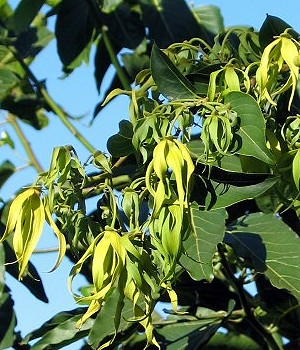
|
|
Ylang-Ylang
- Cananga odorata
|
Ylang-Ylang
- Cananga odorata
Cananga
odorata is an evergreen tree, of Annonaceae family. The Annonaceae family is comprised of about 130 tropical and subtropical
plants, among which are many well-known exotic fruit trees such as the
so-called "custard-apples". The family also includes many other fragrant
plants.
At the forefront of all this Annonaceae splendor
is, of course, Cananga odorata, better known as Ylang-Ylang. It is a large tropical evergreen
tree, whose height can reach up to 60 feet or even more. The golden blossoms adorning the descending branches have
long, slightly twisting petals and an aroma whose presence is detectable from a distance of 30 feet and
more. (Some people can smell the fragrance of this tree many yards away on a windy
day).
It is a fast-growing tree that exceeds 5 meters per year and attains an average height of 12-15
meters. It grows in full or partial sun, and prefers the acidic soils of its native rainforest
habitat. The leaves are long, smooth and glossy. The flower is greenish yellow
(rarely pink), curly like a starfish, and yields a highly fragrant essential
oil. A related species is Cananga fruticosa, which is a dwarf Ylang-Ylang that grows as small tree or compact shrub with highly scented
flowers.
Cananga odorata finds its native habitat in southern
China, Southeastern Asia (Philippines and Indonesia), India, and the Island of
Polynesia, where it grows everywhere - like a fragrant wildfire. Its local
name, "Ylang-Ylang" (or more precisely, "alang-alang") signifies
"the flower of all flowers"; and with its intoxicating, sensual
aroma, it could not be better named.
According to Indonesian folk
custom, Ylang-Ylang awakens love, passion, and secret desire within a
person. Indonesians use the freshly cut petals to decorate the bedrooms and sprinkle on the beds of
newlyweds. The form and fragrance of these flowers is said to strengthen the respective charms of each
partner, increasing their sexual energy and giving them hitherto unknown
enjoyment. Ylang-Ylang is used to guarantee the complete bliss of the wedding
night, which will then remain in the couples' memory for life. With its heady
perfume, Ylang-Ylang plays the role of a mild aphrodisiac - its surprising aroma opens up the human heart and
soul, leaving them defenseless before the strong wave of feelings which
follows. In the Philippines, its flowers, together with the flowers of the
sampaguita, are strung into a necklace and worn by women and used to adorn religious
images
Ylang-Ylang is used widely in perfumery, in both the traditions of the East and in the commerce of the
West.
The fragrance of Ylang-Ylang is rich and deep with notes of jasmine and
neroli.
The oil from Ylang-Ylang is widely used in perfumery for oriental or floral themed
perfumes. Ylang-Ylang blends well with most floral, fruit and wood
smells. Ylang-Ylang lends its seductive soul to some of the most famous fragrances in the
world, including "Chanel No. 5" and "Coco" from the renowned firm of
Chanel; its aroma also constitutes the heart of "Aqua de Gio" from Giorgio
Armani, "Poison" from Christian Dior and "Champs Elysee" from
Guerlain, each of which is no less beloved worldwide in the chosen few of elite
perfumes.
Acording
to perfumerys history, two persons and one plant participated in the creation of the world famous
fragrance, "Chanel No 5". The inventors of this renowned perfume were Gabrielle
"Coco" Chanel, and Ernest Bo (Beaux) who was born in 1881 in
Moscow. Bo was the son of the owner of the perfumery company Rallet, which delivered perfumery to the imperial
court. He later became Rallet's director. Chanel asked Bo to make
"an ideal smell for a woman." In 1921, he presented two series of
samples: from the 1st to the 5th, and from the 20th to the 24th. Chanel chose the 5th, which consisted of the aromas of a
rose, a jasmine and Ylang-Ylang flowers. When questioned about giving it a
name, she answered that the collection would be on sale on the 5th day of the 5th
month, and consequently it was called "Chanel No 5".
The essential oil of the flower is obtained through steam distillation of the flowers and separated into different grades (1, 2, 3,
e.t.c.) according to when the distillates are obtained. The essential oil of
Ylang-Ylang is used in aromatherapy. It is believed to relieve high blood
pressure, normalize sebum secretion for skin problems, and is considered to be an
aphrodisiac.
Source:
http://toptropicals.com/html/toptropicals/
articles/trees/annonaceae_fragrant.htm
http://en.wikipedia.org/wiki/Ylang-ylang
